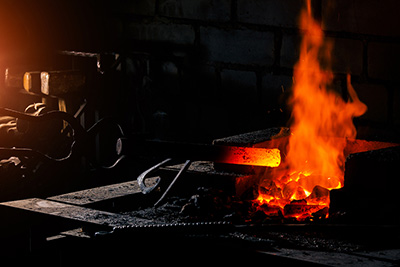TWS is a Great Training Option for Everyone
Learn more about how we can prepare you to advance your career.
The process of heating certain metals to form implements has been around for thousands of years. The introduction of metalworking changed as harder, stronger, sharper, and tougher tools made work easier and more productive. Today’s welders owe their craft to blacksmiths who forged metal tools using little more than heat and hammers.
Early Iron Working
The first iron working looked quite different than welding does today especially with technology automating some of the processes to a degree. During the Iron Age, the most common type of metal produced was wrought iron. Wrought iron was formed as blacksmiths heated metal in a furnace then hammered (worked or “wrought”) into shape. While some processes were invented to refine other irons like cast iron and pig iron into the more useful, wrought iron, it was still inefficient into the 1800s. 1
Discovery of Coke

In the 1700s, converting charcoal to coke for the smelting of iron became widespread due to deforestation as using charcoal required burning wood. This process was later adopted in the United States. The led to the rise of the successful coke production industry in places like Pennsylvania. With the ability to melt down heavier metals came the proliferation of true welding, as individual blacksmiths could melt metal at specific points rather than breaking down an entire piece. In 1881, scientists discovered how to create heat from an arc while the first patent for electrode arc welding was filed ten years later. This led to the decline of blacksmithing, which was eventually replaced by welding. In 1930, the New York Navy Yard developed stud welding, a technique that allowed the mass construction of ships.
Have You Considered a Career in the Skilled Trades?
Fill out the form to recieve a no obligation info packet.
The Emergence of Steel
As anybody with welding training knows, steel has far greater strength, durability, and corrosion resistance than iron. However, up until the 1800s, steel was difficult and expensive to manufacture. This changed after the Bessemer process was introduced. In 1856 he invented a converter that used compressed air to remove carbon allowing wrought iron to be converted to steel making it much cheaper to mass produce. But, the Bessemer was not perfect and some refinements needed to be made. Many other inventors flooded the industry including the open-hearth furnace which converts iron into steal in a broad, open hearth furnace. Steel continued to dominate through the 20th Century.
Welding Today
Today, the United States employs nearly 400,000 welders. 2 Welders have moved past making horseshoes or chainmail like blacksmiths of centuries past did, but instead they tackle modern projects like skyscrapers, aircraft, and even amusement park rollercoasters. As blacksmithing was, welding is still an essential component of a functioning society.
1 – http://www.anselm.edu/homepage/dbanach/h-carnegie-steel.htm
2 – http://www.bls.gov/ooh/production/welders-cutters-solderers-and-brazers.htm#tab-1
This blog has been labeled as archived as it may no longer contain the most up-to-date data. For a list of all current blog posts, please visit our blog homepage at https://www.tws.edu/blog/







